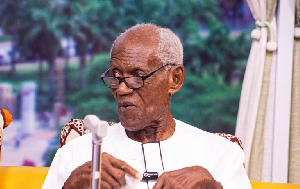Nandom (Upper West), 13 Jan.'99 - Most traditional areas of the Dagaaba in the Upper West Region have reviewed their bride prices downwards to enable the men to marry from home. The Nandom Traditional Council has reduced the dowry of four cows and 13,000 cowries to two cows which should be paid in installments during the couple's life-time, while the 13,000 cowries have now been converted to 27,000 cedis. Naa Poure Puobi Chiir, paramount chief of the area, attributed the review to the scarcity of cowries and the inability of men to produce three cows on the spot before marrying. "The expensive dowry has made our ladies to become flirts because nobody can afford to marry them," he told GRi in an interview yesterday Naa Dana Gore the Second, paramount chief of Dorimon traditional area, said they have reduced the dowry cowries to between nine and 30,000 depending on one's relationship with the family from which he is marrying. Naa Sando Banamini, paramount chief of the Kaleo area, said his people have agreed on 27,000 cowries for young girls and 30,000 for women being remarried. Later in an interview, Mr Charles Dukpe, acting Director of the Centre for National Culture (CNC), attributed the reduction to their frequent educational programmes on the marriage system in the region. He said with Christianity and Islam deep-rooted in the region, the expensive dowries are giving way to less expensive religious marriages. Mr Dukpe said more educational campaigns will be launched this year in all traditional areas so that prospective suitors can now marry from their home communities. "Under the expensive marriage system, it is the women who normally suffer as the men shun their company," Mr Dukpe added.
Nandom (Upper West), 13 Jan.'99 - Most traditional areas of the Dagaaba in the Upper West Region have reviewed their bride prices downwards to enable the men to marry from home. The Nandom Traditional Council has reduced the dowry of four cows and 13,000 cowries to two cows which should be paid in installments during the couple's life-time, while the 13,000 cowries have now been converted to 27,000 cedis. Naa Poure Puobi Chiir, paramount chief of the area, attributed the review to the scarcity of cowries and the inability of men to produce three cows on the spot before marrying. "The expensive dowry has made our ladies to become flirts because nobody can afford to marry them," he told GRi in an interview yesterday Naa Dana Gore the Second, paramount chief of Dorimon traditional area, said they have reduced the dowry cowries to between nine and 30,000 depending on one's relationship with the family from which he is marrying. Naa Sando Banamini, paramount chief of the Kaleo area, said his people have agreed on 27,000 cowries for young girls and 30,000 for women being remarried. Later in an interview, Mr Charles Dukpe, acting Director of the Centre for National Culture (CNC), attributed the reduction to their frequent educational programmes on the marriage system in the region. He said with Christianity and Islam deep-rooted in the region, the expensive dowries are giving way to less expensive religious marriages. Mr Dukpe said more educational campaigns will be launched this year in all traditional areas so that prospective suitors can now marry from their home communities. "Under the expensive marriage system, it is the women who normally suffer as the men shun their company," Mr Dukpe added.












